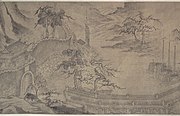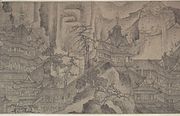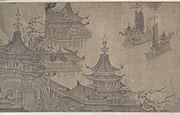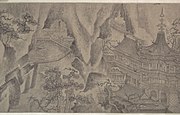Daming Palace
Archaeological site and museum in China From Wikipedia, the free encyclopedia
The Daming Palace was the imperial palace complex of the Tang dynasty, located in its capital Chang'an.[3][4] It served as the imperial residence of the Tang emperors for more than 220 years.[3] Today, it is designated as a national heritage site of China,[5] and part of the UNESCO World Heritage Site "Silk Roads: the Routes Network of Chang'an-Tianshan Corridor".[6] The area is located northeast of present-day Xi'an, Shaanxi Province.[7]
大明宫国家遗址公园 | |||||||
 The reconstructed Danfeng Gate, housing and conserving the on-site ruins of the original gate of the Daming Palace [1] | |||||||
 | |||||||
| Established | 1 October 2010 | ||||||
|---|---|---|---|---|---|---|---|
| Location | Xi'an, Shaanxi, China | ||||||
| Coordinates | 34°17′45″N 108°57′30″E | ||||||
| Type | Archaeological site and history museum | ||||||
| Daming Palace | |||||||
| Simplified Chinese | 大明宫 | ||||||
| Traditional Chinese | 大明宮 | ||||||
| Literal meaning | Palace of Great Brilliance [2] | ||||||
| |||||||
| Daming Palace National Heritage Park | |||||||
| Simplified Chinese | 大明宫国家遗址公园 | ||||||
| Traditional Chinese | 大明宮國家遺址公園 | ||||||
| |||||||
Name
The palace was originally known as Yong'an Palace but was renamed to Daming Palace in 635.[8][9] In 662, after renovations to the palace, it was renamed Penglai Palace.[8][9] In 670, it was renamed Hanyuan Palace[9] or Yuan Palace.[8] Eventually, in 701, the name was changed to Daming Palace again.[8][9]
History
Summarize
Perspective
The former royal residence was the Taiji Palace (太極宮), built in the previous Sui dynasty.[10]
In 632, chancellor Ma Zhou charged that the retired Emperor Gaozu was living in Da'an Palace (大安宮) to the west, which he considered an inhospitable place as it was built on low-lying lands of Chang'an that was plagued by dampness and heat during the summer.[11] According to him, ever since Emperor Taizong moved to the countryside during the summers, his retired father was left behind in Chang'an to suffer in the summer heat.[11] However, his father would always decline any invitation from Emperor Taizong to spend the summer together.[11] Ever since the bloody palace coup of the Xuanwu Gate Incident in 626, it seemed that father and son had drifted apart to an extent that their relationship never healed.[11]
In 634, Emperor Taizong launched the construction of the Daming Palace at Longshou Plateau.[12][13] He ordered the construction of the summer palace for his retired father, Emperor Gaozu, as an act of filial piety.[14] However, Emperor Gaozu grew ill and never witnessed the palace's completion before his death in 635,[11] and construction halted thereafter.
Empress Wu commissioned the court architect Yan Liben to design the palace in 660 and construction commenced once again in 662.[14] In 663, the construction of the palace was completed under the reign of Emperor Gaozong.[15] Emperor Gaozong had launched the extension of the palace with the construction of the Hanyuan Hall in 662, which was finished in 663. On 5 June 663, the imperial family began to relocate from the Taiji Palace into the yet to be completed Daming Palace,[16] which became the new seat of the imperial court and political center of the empire.[9][16][17]
Layout and function
Summarize
Perspective

Beginning from the south and ending in the north, on the central axis, stand the Hanyuan Hall, the Xuanzheng Hall, and the Zichen Hall.[8] These halls were historically known as the "Three Great Halls" and were respectively part of the outer, middle, and inner court.[8] The central southern entrance of the Daming Palace is the Danfeng Gate.[1] The gate consisted of five doorways.[18]
The present site covers more than 4,800 mu, making it 3.5 times more expansive than the Forbidden City, 3 times more than Versailles, and 13 times more than the Louvre.[19]
Outer court
After passing through the Danfeng Gate, there is a square of 630 metres (2,070 ft) long with at the end the Hanyuan Hall.[20] The Hanyuan Hall was connected to pavilions by corridors, namely the Xiangluan Pavilion in the east and the Qifeng Pavilion in the west.[8][21] The pavilions were composed of three outward-extending sections of the same shape but different size that were connected by corridors.[21] The elevated platform of the Hanyuan Hall is approximately 15 metres (49 ft) high, 200 metres (660 ft) wide, and 100 metres (330 ft) long.[7] The Hanyuan Hall, where many state ceremonies were conducted, would serve as the main hall for hosting foreign ambassadors during diplomatic exchanges.[7]
- Reconstruction model of Hanyuan Hall
- Hanyuan Hall's platform
- Hanyuan Hall's platform
Middle court
The Xuanzheng Hall is located at a distance of about 300 metres (980 ft) north of the Hanyuan Hall.[8] State affairs were usually conducted in this hall.[22] The office of the secretariat was located to the west of the Xuanzheng Hall and the office of the chancellery was located to the east.[23] From this area, structured in a Three Departments and Six Ministries system, the Department of State Affairs, the Chancellery, and the Secretariat handled the central management of the Tang empire.[23]
Inner court
The Zichen Hall, located in the inner court,[23] is approximately 95 metres (312 ft) north of the Xuanzheng Hall.[8] It housed the central government offices.[24] For officials, it was considered a great honor to be summoned to the Zichen Hall.[23] The Taiye Pool, also known as the Penglai Pool, is north of the Zichen Hall.[25] The former gardens that surround the pond and island have been recreated, based on the historical record, with peony, chrysanthemum, plum, rose, bamboo, almond, peach, and persimmon gardens.[26]
The Linde Hall is located to the west of the lake.[24] It served as a place for banquets, performances, and religious rites.[27] It consisted of three halls—a front, middle, and rear hall—adjacent to each other.[27] An imperial park could be found north of the palace complex.[24] The Sanqing Hall was located in the northeast corner the Daming Palace and served as a Taoist temple for the imperial family.[24][25]
- Model of the Linde Hall
- Linde Hall's platform
Border
The area around the palace complex grounds is currently planted with locust trees, willows, flowers, and bushes on all sides.[26]
Heritage

The site of the Daming Palace was discovered in 1957.[28] Between 1959 and 1960, the earliest surveys and excavations of the Hanyuan Hall site were carried out by the Institute of Archaeology of the Chinese Academy of Sciences.[21]
Preventive conservation measures of the Hanyuan Hall site began in 1993.[7] From 1994 to 1996, for the restoration and preservation of the site, numerous surveys and excavations were conducted.[21] The State Administration of Cultural Heritage (SACH) and UNESCO drew up and adopted a two-phased plan by 24 July 1995 to safeguard the Hanyuan Hall site.[7][28] Work on the project started in 1995 by the joint effort of the Chinese government, Chinese and Japanese institutes, UNESCO, and various specialists.[29] Most of the conservation work concluded in 2003.[7][29]
On 1 October 2010, the Daming Palace National Heritage Park was opened to the public.[30] There are many exhibition halls located throughout the site of the palace complex to showcase the excavated cultural relics of the site.[8]
Gallery
- Daming Palace, attributed to Wang Zhenpeng (fl. 1275-1330) but likely 15th century production
See also
- Huang Chao, whose revolt caused the destruction of the palatial complex
References
Wikiwand - on
Seamless Wikipedia browsing. On steroids.














